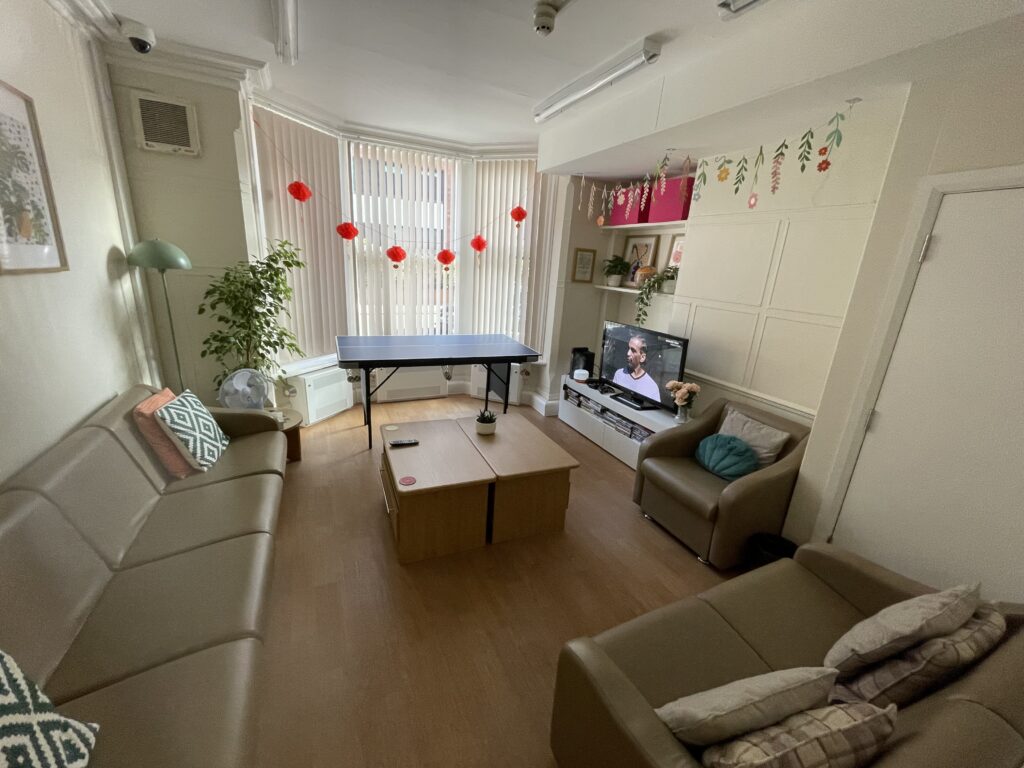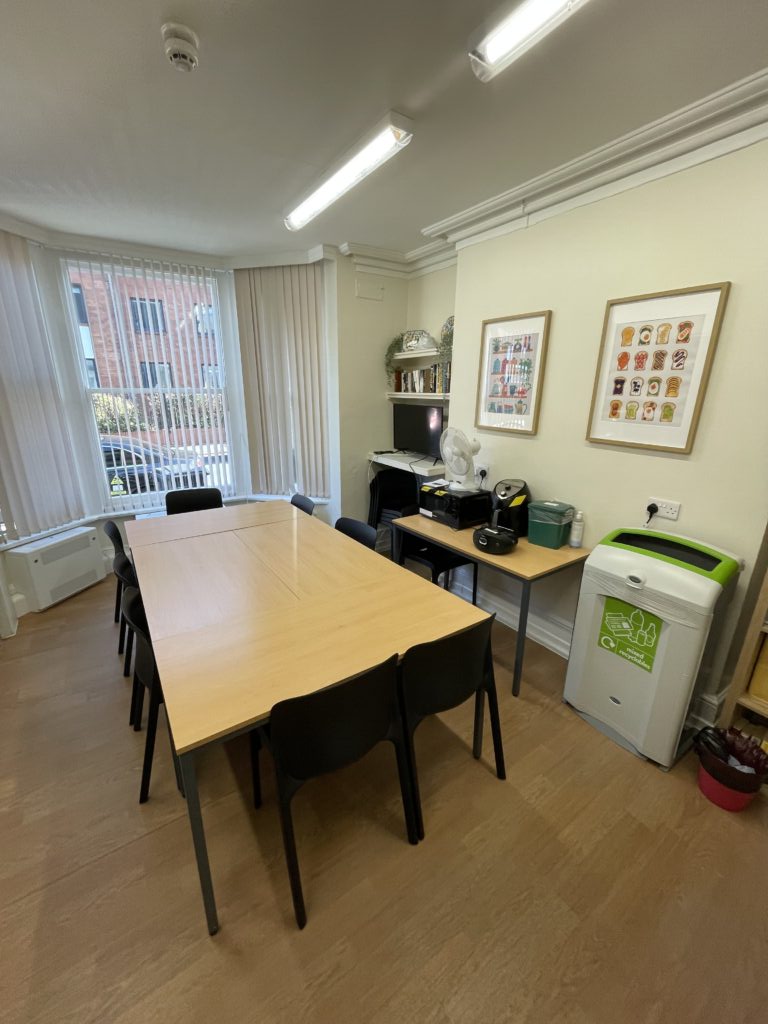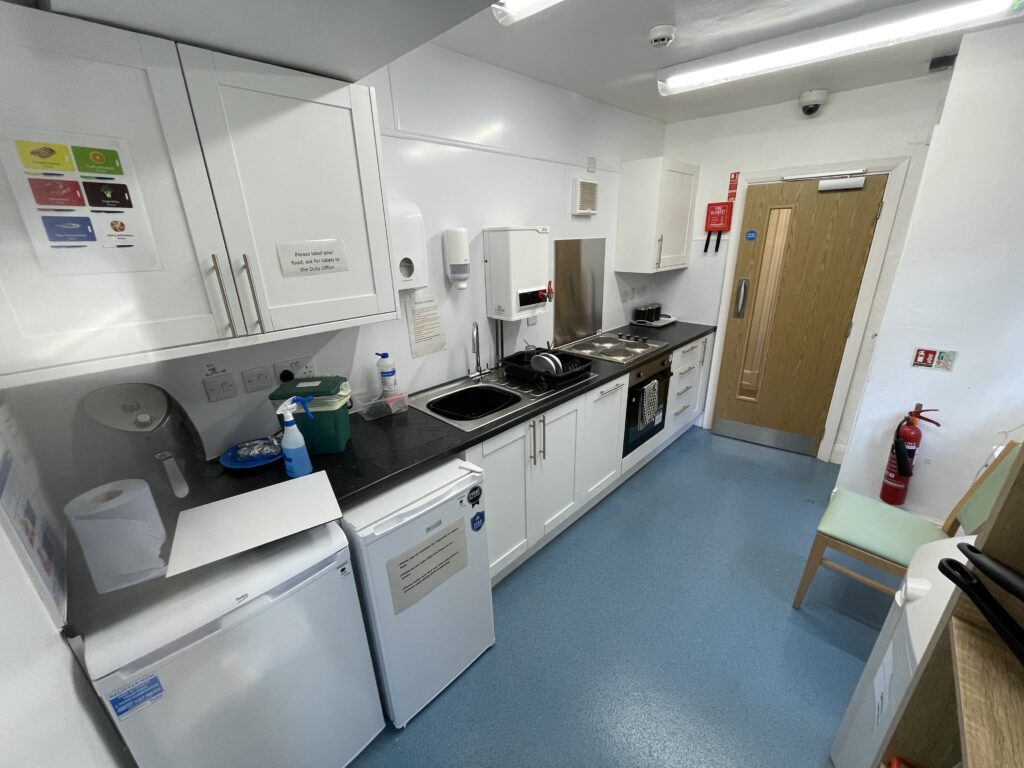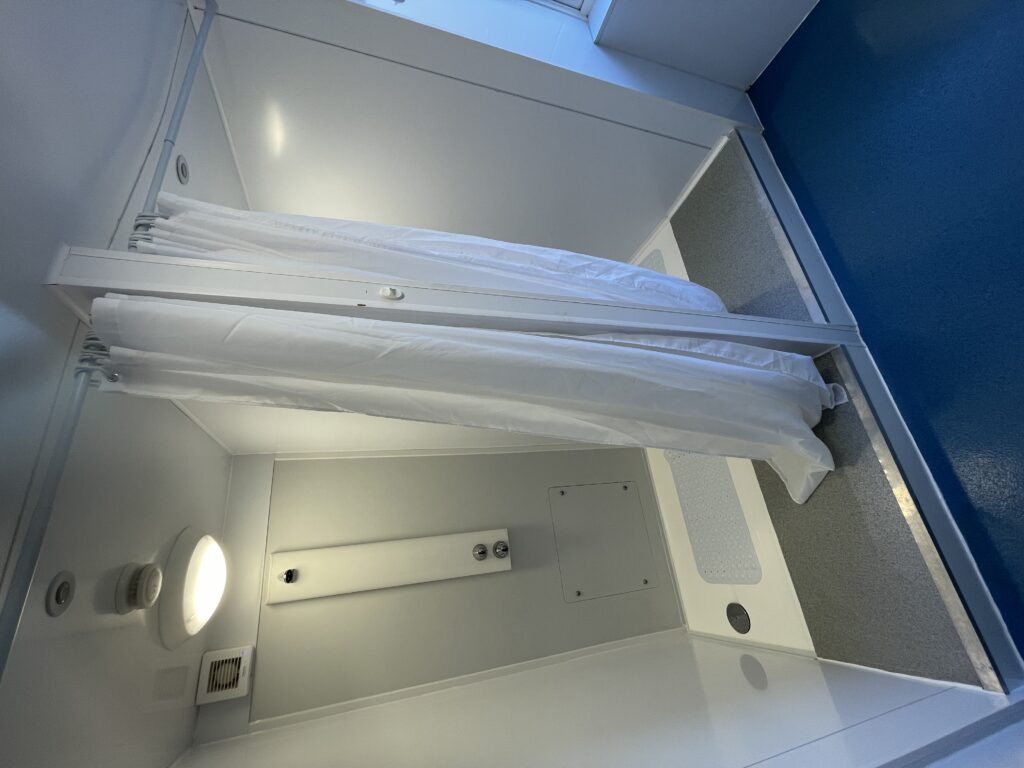An inspection of Howard House Approved Premises
Foreword (Back to top)
This is our third inspection under the new programme for approved premises (APs), and it is encouraging to report another positive outcome.
Howard House has been rated ‘Good’ overall — a rating that reflects the dedication and commitment of its leaders and staff, a strong emphasis on safety, and effective public protection practices.
We were impressed by the recent refurbishment, which has created a warm and welcoming environment for both staff and residents. However, the extended period of closure has clearly disrupted relationships with key partners. As a result, we found that services and opportunities were limited, which was having a noticeable impact on the AP’s ability to support rehabilitation and resettlement.
We also found staffing challenges, and while we were impressed by management’s commitment to step in and fill gaps when needed, this inevitably had a significant impact on other key areas of work, including oversight and quality assurance. Our recommendations highlight the need to address these issues to strengthen operational delivery at Howard House.
It is clear that Howard House has a solid platform from which to continue developing its work, and I wish the team every success for the future.
Martin Jones CBE
HM Chief Inspector of Probation
Contextual information and background (Back to top)
| Total number of approved premises nationally | 104 |
| Length of time on site including out-of-hours activity | 2 days |
| Total number of beds in Howard House | 13 |
| Average length of residents’ stay at Howard House | 41 days |
Nationally
Approved premises (APs) play a vital role in managing some of the highest-risk individuals supervised by the Probation Service. There are 104 APs across England and Wales, most of which are men-only, with eight dedicated to women. Twelve APs operate as psychologically informed planned environments (PIPEs), co-commissioned with NHS England. Fourteen APs are independently run by third sector providers under contract and in partnership with HM Prison and Probation Service (HMPPS), including five of the eight women’s APs.
Locally
Howard House is a public sector AP with capacity to accommodate up to 13 men across eight rooms: five single-occupancy, one double-occupancy, and two triple-occupancy rooms. The premises underwent a full refurbishment and reopened approximately one year ago, following a two-year closure for renovation works. At the time of our inspection, there were 10 residents in placement.
Our inspection methodology
We carried out our inspection of Howard House AP during the week commencing 08 September 2025. This included an offsite review of eight cases involving individuals who were either current residents or had left the AP within the previous three months. During our onsite fieldwork, we observed practice, interviewed managers and staff, both individually and in groups, and gathered feedback from five current residents about their experiences. We also observed the AP’s ‘out-of-hours’ operations, including early morning and evening shift handovers, and conducted a review of recent enforcement and recall decisions.
Ratings (Back to top)
| Fieldwork started September 2025 | Score 8/15 |
| Overall rating | Good |
| Standard | Score | Rating |
| Leadership | 2 | Good |
| Staffing | 1 | Requires improvement |
| Safety | 2 | Good |
| Public protection | 2 | Good |
| Rehabilitation | 1 | Requires improvement |
Recommendations (Back to top)
As a result of our inspection findings, we have made the following recommendations that we believe, if implemented, will have a positive impact on the quality of services delivered at Howard House.
The Howard House leadership team should:
- improve pre-arrival planning to ensure residents have a realistic understanding of what to expect, and that their individual needs are identified and addressed from the outset
- ensure there is a timetable of structured and planned rehabilitative activities to support residents reintegrate into the community, maximising partner involvement in the AP
- provide formal, structured supervision for all staff to improve oversight and enhance the quality of casework
- implement a systematic quality assurance process to consistently monitor, improve, and sustain the quality of work with residents
- ensure staff access national training to support consistent application of key policies and processes, and to develop their skills and confidence.
His Majesty’s Prison and Probation Service should:
- ensure the AP manager has sufficient capacity and resources to provide effective oversight and drive quality improvements in casework
- review the proportion of shared bedrooms to ensure decency standards are upheld and individual needs are appropriately met
- review the central referrals unit (CRU) practices to prevent overbooking and ensure AP capacity is managed safely.
Leadership and governance (Back to top)
| Leadership and governance drive the delivery of a high-quality service. | Rating |
| Good |
Strengths:
- The AP manager had collaborated with a small group of staff to develop a shared vision for the AP, which was prominently displayed throughout the premises and reflected a commitment to delivering a personalised approach for all residents, regardless of their offending history. There were clear plans to build on this initial work by engaging a wider group of staff, with the aim of embedding the vision more fully.
- Howard House fostered a warm, inclusive, and supportive culture, underpinned by leaders who modelled respectful and constructive behaviours. Through their visible presence and commitment to open communication, leaders introduced a range of forums that encouraged staff engagement and enabled individuals at all levels to raise concerns, ask questions, and share reflections. These approaches helped create a psychologically safe environment, where staff felt heard and valued.
- The AP had established mechanisms for gathering resident feedback and using it to inform service improvements. Residents’ views were routinely sought through structured processes, including end-of-placement questionnaires and weekly house meetings. The AP manager reviewed feedback and shared it with staff to support learning and development.
- There was collaboration with external agencies to manage risks and to enable opportunities for residents. There was a strong relationship with the local MOSOVO (management of sexual offenders and violent offenders) police team, who visited the AP regularly. Reconnect, a service provided by Leicestershire Partnership NHS Trust, also visited the AP regularly to support residents with health vulnerabilities in their transition from custody to the community.
- At the time of our inspection, all residents were registered with a local GP, and the AP had an agreement with a local pharmacy to facilitate prescription requests, although the relationships with these providers were relatively new and still under development.
- There was a strong performance culture embedded, and the AP had performed consistently well against national service level measures in recent months. Leaders actively monitored delivery expectations and engaged staff in developing their understanding of the relevance of these measures to their roles.
- Leaders demonstrated a clear commitment to staff development, reflected in structured mentoring, access to varied learning opportunities, and regular forums that supported professional growth and peer collaboration. In response to staff feedback, leaders had also developed bespoke face-to-face training which provided staff across the division with the opportunity to develop their skills and connect with colleagues.
- There was evidence of thoughtful consideration of diversity needs at a local level, with inclusive practices embedded in day-to-day operations. All residents had completed a diversity questionnaire at induction, and diversity factors were actively considered during room allocation to ensure appropriate sharing arrangements. The premises were also equipped with dedicated facilities for halal food preparation, supporting residents with religious dietary requirements.
Areas for improvement:
- While there was a strong commitment to staff development, staff reported that they were not always given dedicated time during working hours to complete eLearning. Providing protected time and space would help staff engage more meaningfully with their learning and development. Additionally, we identified learning and development needs amongst the AP staff group that could be met via the national training offer; however, this was not being utilised.
- There was no routine quality assurance activity, and our inspection of cases highlighted that there were deficits in the quality of some areas of casework. These could be addressed by strengthening quality assurance processes.
- Whilst some partnership arrangements were in place, others were underdeveloped, limiting the support available to residents. Partnership working required further development to ensure residents had regular access to external services that supported rehabilitation and wellbeing.
Staffing (Back to top)
| Staff are enabled to deliver a high-quality service for residents. | Rating |
| Requires improvement |
Strengths:
- Staff at Howard House demonstrated passion for their roles and enjoyed working at the AP. We observed staff to be motivated and engaged.
- Staff had built strong, positive relationships with residents by showing genuine care and taking time to understand individual needs. Observations confirmed that staff interactions were respectful and professional, and in all inspected cases, strong working relationships between staff and residents contributed positively to rehabilitation outcomes.
- A strong and unified team culture was evident at Howard House, and staff showed flexibility in providing cover during staffing shortages. Due to its proximity to another AP, Howard House was also able to benefit from shared staffing resource to ensure service continuity.
- Staff received a local induction that involved on-the-job training and shadowing of more experienced colleagues. Howard House also benefited from strong links with the local probation delivery unit (PDU), which enabled AP staff to participate in the Probation Service corporate induction programme.
- From the activities observed on site, it was evident to the inspection team that staff were skilled and trained in de-escalation and behaviour management, safeguarding, risk assessment, and trauma-informed practice.
- Management took a proactive approach in working collaboratively with PDU colleagues to deliver bitesize learning sessions. These focused on AP placements, the expectations of probation practitioners managing cases within the AP, and strategies to support residents in successfully completing their placements. In addition, management facilitated a quarterly interface group with the head and deputy head of the PDU, providing a structured forum for information sharing and learning.
- There was a clear and proactive focus on staff wellbeing at Howard House, with management taking practical steps to support staff safety, emotional resilience, and day-to-day working conditions. Staff received appropriate support following critical incidents, including referrals to Trauma Risk Management (TRiM), a peer-support model for those exposed to traumatic events. Staff sickness was also managed effectively, with reasonable adjustments made where needed.
Areas for improvement:
- Staffing at Howard House was stretched with vacancies in the probation service officer (PSO) and residential worker (RW) roles, and long-term sickness absences. Consequently, the AP manager had been covering RW shift gaps when necessary, alongside fulfilling out-of-hours on-call duties one week in every three. This situation warranted attention, particularly for the AP manager’s workload, to ensure that management capacity was aligned with key priorities.
- While management maintained an open-door policy and a strong, visible presence, formal and structured supervision for staff occurred infrequently, and there was no established quality assurance process to monitor casework standards. Strengthening formal supervision, and introducing systematic quality assurance, were necessary to enhance and sustain the quality of work with residents.
- Staff reported that before annual leave could be approved, they were expected to arrange cover among colleagues, which was proving challenging given the already stretched staffing levels. This approach should be reviewed to reduce the pressure on individuals to arrange their own cover, particularly in the context of limited staffing capacity.
- While there were processes for inducting new staff, the national induction training for AP staff was not being utilised. Ensuring staff attended this training would help build competence and promote consistent understanding and application of key national policies, procedures, and values.
Safety (Back to top)
| The approved premises provides a safe, healthy, and dignified environment for staff and residents. | Rating |
| Good |
Strengths:
- Staff managed risks of suicide and self-harm well, demonstrating high levels of attentiveness to residents’ wellbeing, and responding appropriately to individuals at heightened risk through additional welfare checks and meaningful conversations. These issues were routinely discussed during staff handovers, where staff showed professional curiosity and ensured a clear understanding of each resident’s circumstances and associated risks.
- Prescribed medication, including controlled substances, were securely stored and effectively administered in line with national policy and legislation.
- Staff demonstrated competence in responding to safeguarding concerns, taking appropriate action in all relevant cases, such as increasing monitoring when substance use was suspected and supporting residents to access medical care. Additional welfare checks were carried out collaboratively with residents where needed, and prompt management action was taken to review room allocations in response to safeguarding and wellbeing concerns.
- The AP manager promoted a strong safety culture in Howard House by proactively ensuring that risks were clearly understood and managed through safer systems of work, such as requiring staff to work in pairs when lone working was deemed unsafe.
- Our review of recent enforcement decisions, including those undertaken out of hours, evidenced the AP’s ability to assess and manage emerging and escalating risks. AP staff were familiar with enforcement processes used to manage residents’ poor behaviour and were able to clearly articulate these, placing emphasis on the use of relational skills to address low-level concerns at the earliest opportunity, thereby preventing escalation.
- Howard House had been fully refurbished and had reopened approximately one year previously. We were impressed by the warm and homely environment and the exceptional cleanliness. The non-clinical feel of the AP was a key strength, underpinned by evidenced-based principles of trauma-informed and person-centred care.
- Security measures at Howard House were effective. There was good CCTV coverage, and we observed staff wearing safety belts and carrying portable radios when moving throughout the communal areas. Staff and visitors were given personal assistance alarms which were tested before being handed out.
Areas for improvement:
- While the management of suicide and self-harm risks was generally effective, the associated documentation and recording practices were inconsistent. Improvements were needed to ensure that records were maintained with greater consistency, regularity, and completeness.
- The premises could accommodate up to 13 men across eight rooms: five single-, one double-, and two triple-occupancy rooms. The practice of room sharing undermined the decency of provision, particularly through the lack of personal privacy and the disruption to sleep caused by noise and differing routines. These conditions adversely affected residents’ wellbeing and placed a significant burden on management to coordinate the arrangements. Consideration should be given to the proportion of shared bedrooms within the unit, given the impact of these arrangements upon operational efficiency.
Public protection (Back to top)
| The approved premises effectively protects the public | Rating |
| Good |
Strengths:
- Howard House was appropriately represented at MAPPA (multi-agency public protection arrangements) meetings, with attendance shared between the area manager, AP manager, and keyworker in accordance with their respective roles and grades.
- We received examples where the AP manager had used the appeals process effectively and had successfully challenged unsuitable allocation decisions by the central referrals unit (CRU).
- During fieldwork, inspectors observed timely and proportionate enforcement decisions in response to escalating risks. In our inspections of casework, we also noted that enforcement decisions had been clearly and consistently recorded within case records.
- The AP staff conducted frequent and thorough room searches. Inspectors were provided with several examples of actions taken to safeguard adults and children as a result of findings from these searches.
- The area manager facilitated a quarterly management interface group with the head and deputy of the PDU, providing a structured forum for information sharing. Minutes from these meetings evidenced effective collaboration in managing risk through joint oversight of enforcement decisions, safeguarding actions, referral processes, and operational challenges.
- The AP maintained a positive working relationship with the MOSOVO police team, and inspectors were given examples of effective liaison in response to escalating risks presented by residents. In the eight cases reviewed, there was clear evidence of effective information sharing and collaboration with external agencies where required to manage risk.
- During fieldwork, we observed two shift handovers that were thorough and well-documented. Staff discussed all residents and demonstrated professional curiosity to ensure clarity and shared understanding.
- Regular drug and alcohol testing was evident within the eight cases we inspected with appropriate actions taken in response to positive results. We also reviewed case examples from the previous three months, which demonstrated extensive drug and alcohol testing, and appropriate decisions in response to positive test results and emerging risks.
Areas for improvement:
- To maximise the utilisation of AP bed spaces, the CRU operated an overbooking process guided by clearly defined criteria. While non-arrivals and early departures typically provided some flexibility to accommodate overbookings, AP managers were expected to honour all confirmed placements, as set out in policy. This could result in the early relocation of existing residents, a practice that was evident in our case inspections. This issue warranted attention, as it placed undue pressure on the AP and could compromise public protection.
Rehabilitation (Back to top)
| The approved premises delivers activity to reduce reoffending | Rating |
| Requires improvement |
Strengths:
- Our inspection of cases found that most residents received a suitable and timely induction at the AP. Howard House also consistently performed well against service level measures for the prompt delivery of the two-stage induction process.
- Keywork sessions were delivered regularly, with evidence of effective joint working between keyworkers and probation practitioners. Residents surveyed during inspection rated their keywork sessions as either “excellent” or “good”.
- There was a clear commitment to strengthening relationships with local providers, with good foundations already in place to support further development. Residents with substance misuse issues were linked in with Turning Point and attended appointments at their offices within Leicester City Centre. Additionally, a lived-experience session led by Alcoholics Anonymous (AA) was held at the AP and received positive feedback from residents. There were plans to make these sessions regular, although these were still being developed at the time of the inspection.
- The AP offered a range of social activities, including film and quiz nights. One practical session involved shared cooking, which supported residents in developing skills for independent living.
- In seven of the eight inspected cases, rehabilitative work delivered by Howard House was aligned with sentence plan objectives and complemented the work of probation practitioners. Evidence of joint working between AP staff and probation practitioners was also observed.
- Staff-resident interactions were consistently positive and professional. Staff demonstrated a genuine interest in residents and appeared motivated to support their progress. These strong relationships provided a foundation on which effective rehabilitation could be developed.
Areas for improvement:
- There were limited rehabilitative opportunities available within the AP, which meant residents were unable to engage in six activities per week, as per national expectations, due to the lack of provision. There was a need for more structured and consistent activities at Howard House to meet the rehabilitative needs of all residents.
- Management acknowledged that some staff were hesitant to deliver activities, highlighting a culture where this was not universally embraced. This reluctance warranted further exploration to understand the underlying reasons. Where appropriate, staff should be supported to build their confidence and develop the skills needed to contribute fully to the rehabilitative programme.
- We found no evidence of pre-arrival contact with residents prior to their admission. This was a critical area of practice, particularly for managing expectations about shared rooms and reducing the risk of conflict or distress upon arrival.
- Management should explore additional opportunities and resources to better support residents in their move-on planning and successful transition into the community.
Further information (Back to top)
This inspection was led by HM Inspector Claire Andrews, supported by a team of inspectors and colleagues from across the Inspectorate. We would like to thank all those who helped plan and took part in the inspection; without their help and cooperation, the inspection would not have been possible.
Images (Back to top)




